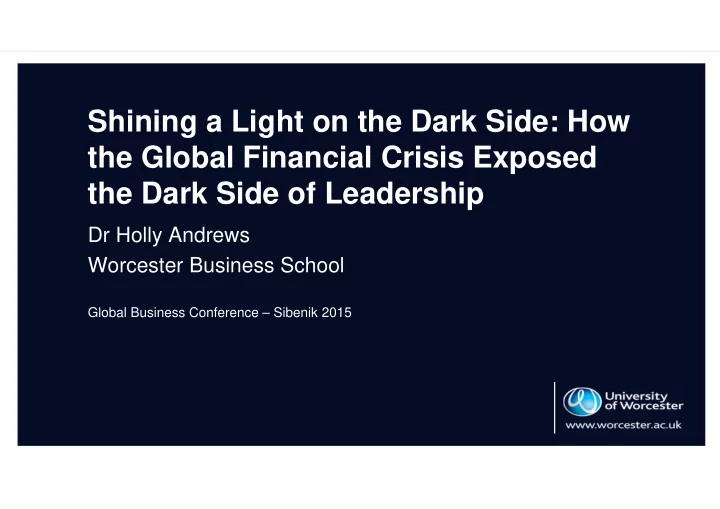

Shining a Light on the Dark Side: How the Global Financial Crisis Exposed the Dark Side of Leadership Dr Holly Andrews Worcester Business School Global Business Conference – Sibenik 2015
Overview What is the issue? Introducing psychopathy in the workplace Where do psychopaths work? What is the impact of workplace psychopaths? What can we do about it?
Heads of OR offsite – June 2011 What is the issue? | 3
Destructive leadership • 50% of leaders fail (Hogan et al., 2010) • Failure is not necessarily attributed to not having enough of the ‘good’ stuff; Failure is often due to possessing traits which fall into the ‘dark side’ of personality (Hogan, 2009; Hogan & Hogan, 2009; Spain et al., 2013). • Such traits are implicated in a host of issues for organisations including poor staff morale and satisfaction, bullying, poor levels of productivity, high staff turnover, unethical behaviour and even white collar crime (see Spain et al., 2013 for a summary).
What is psychopathy?
What is psychopathy? Factor 1: Arrogant and Deceitful Interpersonal Style 3 factors of Glib Grandiose psychopathy (Cook Conning/manipulation Pathological lying & Michie,2001) Factor 2: Deficient Affective Experience Clinical psychopaths Shallow affect Callous lack of empathy have large numbers Lack of remorse of characteristics in Failure to accept responsibility Factor 3: Impulsive and Irresponsible Behavioural Style each factor Need for stimulation/proneness to boredom Evidence suggests Irresponsibility Impulsivity the disorder is Parasitic lifestyle dimensional Lack of long-term goals
Psychopaths in the workplace • Babiak (1995, 2000) Case studies of clinically diagnosable individuals currently employed within organisations. • Boddy (2010), Boddy et al. (2010a, 2010b) Empirical studies showing that other’s report working with psychopathic individuals. • Lilienfeld et al. (2014) Self-report measure of psychopathy in the workplace. • Babiak et al. (2010) application of the PCL-R in the workplace. • Board & Fritzon (2005) high levels of psychopathy in British CEOs • Show evidence of individuals with high levels of psychopathic traits working within organisations.
Looking on the bright side of the ‘dark side’ “Organisational Psychopaths” Publications from 1960-2015 30 Average number of publications per year 25 20 1960-2007 15 2008-2015 10 5 0 Year
Where do psychopaths work? • Little research identifying what kinds of organisations psychopaths work for. • Boddy (2011) implicates psychopaths in the global financial crisis • Boddy (2010) found that highest numbers of psychopaths are working within finance, insurance, banking and communications companies and the lowest numbers in retail, wholesale, accommodation and transport companies. • Lilienfeld et al. (2014) found higher levels of psychopathy in business roles compared to psychology and mental health.
Realistic Conventional Investigative Holland’s RIASEC model Enterprising Artistic Social
Research methodology • Quantitative survey of alumni of UK Universities • Self-report measures of psychopathy and occupational choice • Logistic regression used to assess whether Egotism, Callousness and Antisocialism predict the general occupational theme of occupational choice
Results CURRENT GRADUATE ROLE FIRST GRADUATE ROLE
So what does it mean? ENTERPRISING AND CONVENTIONAL REALISTIC
Psychopaths in the boardroom and organisational risks Financial risk from poor decisions, self-promoting behaviour and lack of loyalty Reputational risk from exposure of negative behaviours and culture Sustainability risks from losing or failing to develop talent
Management Talent Selection What can be done? Recruitment
Questions?
References Babiak, P. (1995). When psychopaths go to work: A case study of an industrial psychopath. Applied Psychology, 44 (2), 171-188. Babiak, P. (2000). Psychopathic manipulation at work. In C. Gacono (Ed.), The clinical and forensic assessment of psychopathy: A practitioner's guide (pp. 287-312) Lawrence Earlbaum. Babiak, P., Neumann, C. S., & Hare, R. D. (2010). Corporate psychopathy: Talking the walk. Behavioral Sciences & the Law , 28 (2), 174-193. Boddy, C. R. (2010). Corporate psychopaths and organizational type. Journal of Public Affairs , 10 (4), 300-312. Boddy, C. R., Ladyshewsky, R. K., & Galvin, P. (2010a). The influence of corporate psychopaths on corporate social responsibility and organizational commitment to employees. Journal of Business Ethics , 97 (1), 1-19 Boddy, C. R., Ladyshewsky, R., & Galvin, P. (2010b). Leaders without ethics in global business: Corporate psychopaths. Journal of Public Affairs , 10 (3), 121-138. Cooke, D. J., & Michie, C. (2001). Refining the construct of psychopathy: towards a hierarchical model. Psychological Assessment, 13 , 171-188. Hogan, R. (2009). Hogan development survey manual. Hogan Assessment Systems. Hogan, J., Hogan, R., & Kaiser, R. B. (2010). Management derailment. American Psychological Association handbook of industrial and organizational psychology, 3, 555-575. Lilienfeld, S. O., Latzman, R. D., Watts, A. L., Smith, S. F., & Dutton, K. (2014). Correlates of psychopathic personality traits in everyday life: results from a large community survey. Frontiers in Psychology , 5 . Spain, S. M., Harms, P., & LeBreton, J. M. (2014). The dark side of personality at work. Journal of Organizational Behavior, 35 (S1), S41-S60.
Recommend
More recommend